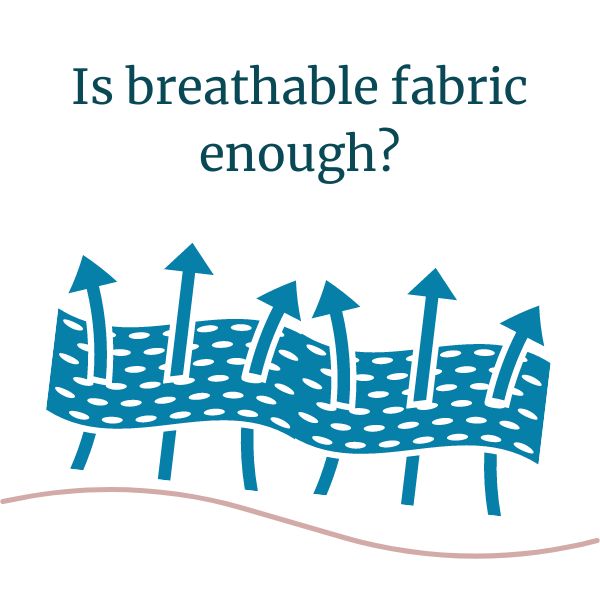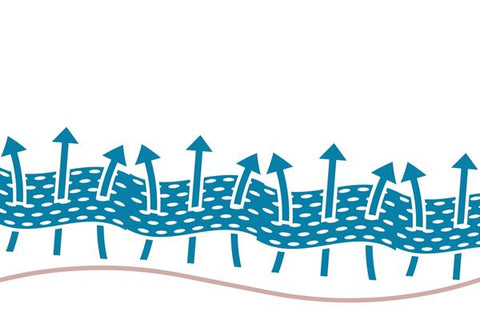
Is Breathable Fabric the Key to a Good Sleep for Night Sweats Sufferers?
Share

I suffered from night sweats for over 2 years before I finally realized I had to do something. Honestly, I lived in denial, thinking they would just disappear on their own.
I had been sleeping in an old, indestructible polyester nightgown, waking up all night long, cover flipping because I was too hot or too cold. In the morning I was soaked and exhausted.
I decided that the best way to sleep better was to get sleepwear made from 100% cotton because it was such a breathable fabric. The first night in my new nightgown I went happily to sleep that night knowing I'd finally get the slumber I'd been seeking for far too long.
It didn't work. I was in just as bad shape as I had been with the old polyester nightgown. In fact, after a month of sleeping in the cotton nightgown, it had permanent sweat stains around the chest area and under the arms and I was still exhausted and soaked every morning.
What does "breathability" mean?
Breathability in fabric is the ability for air to pass from one side of fabric to the other. It is all about airflow and does not address heat or moisture – the two properties that affect night sweats sufferers the most.
Cotton is breathable, but as I discovered, it loves water. In fact, a cotton nightgown clings to water, keeping you chilled and damp under your covers.
If cotton isn’t the answer for night sweats sufferers, what do we wear to bed?
In order for a fabric to effective enough to keep you dry through all your night sweats cycles, it needs to be able to do 2 things in addition to being breathable:
- Draw moisture away from your skin AND let it evaporate (let go of that water molecule)
- Draw heat away from your skin, let most of it go, BUT store some in the fibers for later. This last little action is really important for night sweats' sufferers because our body temperature changes so dramatically and in such a short time frame. It goes from peak to valley to normal. As your body temperature drops below its normal basal level, you feel chilled until it rises to normal. If the fabric can release that stored heat when you need it, you don't feel chilled.
Here's a quick explainer video that we put together for our product to show how fabric and your night sweats interact:
Which fabrics moderate heat and moisture best?
Here are our suggestions, based on research, testing and personal experience:
Excellent:
- Hemp
- Linen
- Merino wool (very fine)
Very good:
- Tencel, especially made from bamboo
Acceptable:
- Rayon/Viscose
But even with these breathable, responsive fabrics you still need to consider a few other factors:
Fabric density: If you have severe night sweats, you’ll want a light to medium weight sleepwear. When it’s thicker and denser it can still trap too much heat and the moisture may take longer to evaporate. Linen, hemp and Merino wool all have insulating properties, so you want to make sure you are buying sleepwear made from light-weight versions of these fabrics.
Blend type: There are a lot of great blends out there that can work for you. For instance, in our sleepwear we use a 55%/45% hemp/cotton blend. Our pillowcases use a hemp/lyocell blend. The higher the hemp component, the more responsive the fabric will be. We like the blend because the fabric takes the best of hemp’s responsiveness and the softness of cotton so it's comfortable and effective.
What you’re looking for in other fabrics is ensuring that the wicking and heat managing fiber is the majority of the blend.
There are also treated cotton-polyester fabric blends that are extremely effective. They were developed specifically for moisture-wicking and heat management. Sometimes they have been treated with a coating or infusion into the fiber so it will respond to your heat and moisture.
Which fabrics should you stay away from if you suffer from night sweats?
- 100% Cotton
- Polyester and nylon
- Silk
- Wool except for Merino wool
All of these fibers are either insulating or poor moisture managers – notice there are 3 natural fibers on this list! Breathability isn’t the only property you need for more responsive sleepwear.
Check the fabric labels
You can learn a lot about the garment and how well it will respond to your body’s heat unpredictability by feeling the fabric and reading the material label. The next time you're looking for sleepwear, keep these points in mind and you should have a much more comfortable trip to slumberland.
In the next post we’ll look at how your bed linens play a significant role in your sleep comfort with night sweats.
You mIght also like:
What Not To Sleep In When You Have Night Sweats
Hot Sleeper, Cold Sleeper - Your Sleepwear Influences Your Sleep Comfort
